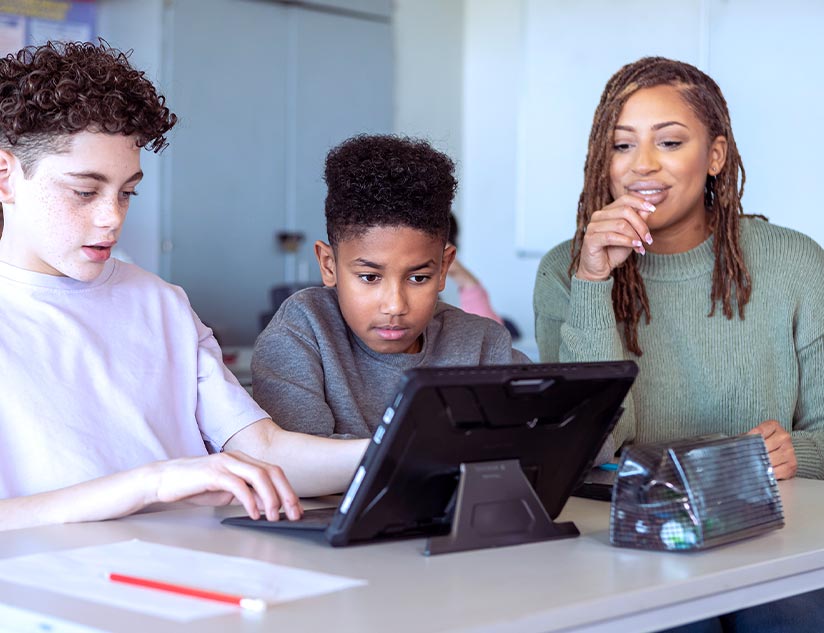AI and Teacher Facilitation: Maximizing Learning Outcomes for Students
March 14th, 2024
The education technology industry accounts for 6% of the global GDP, although it is still in its early stages. No-Code AI is the latest transformative force revolutionizing digital learning and teaching experiences. AI is consistently transforming the role of educators, facilitating them to offer outcome-driven, targeted education tailored to individual needs and learning outcomes. This blog dives into how the adoption of technological advancements, such as AI, is empowering teachers in the digital era.
Profound Transformation in the Education Landscape
The large-scale acceptance of digital education has led to the emergence of new learning formats. These include microlearning, MOOCs, blended learning, and social learning. Further, technology integration in learning design has led to the evolution of pedagogy with flipped classrooms, gamified education, and personalized learning.
Artificial intelligence has been instrumental in pivoting education toward a future of greater accessibility, inclusion, and autonomy. AI has become ubiquitous, changing the skill and knowledge requirements for diverse job roles as well. Thus, AI has transformed the goal of education. Critical thinking is all the more important for individuals to successfully leverage technology and not get caught up with its limitations. In addition, advanced technologies have transformed the role and lives of teachers through automated content creation, assessment, feedback, student data management, report generation, and much more.
The Transformational Role of AI
With student-centeredness penetrating deeper into education methodologies, the role of teachers is transitioning into that of a facilitator, while AI in education has gained significance in offering diagnoses, recommendations, and predictions. This helps identify and bridge learning gaps, provides specialized learning support, and enables real-time interactions and assessment for remote learners to make learning and teaching more effective. The technology helps deliver personalized and adaptive learning to bolster student engagement, which helps teachers develop a better understanding of students’ learning processes.
AI Bridging Gaps in Education
Teachers or books are no longer the only sources of information. Intelligent tutoring systems, AI-powered learning assistants, and automated content creation have made plenty of knowledge available to students. These systems can even create unique and personalized learning journeys to deliver the desired learning outcomes. Hence, the role of a teacher is changing into that of an enabler to help students develop learning strategies that work best for them to better achieve their learning goals. Additionally, the emphasis on the social-emotional well-being of students is growing, especially for those with inadequate access to learning or individual challenges.
AI’s Role in Shaping Teacher Facilitation Methods
A facilitator-teacher recognizes that learning is a collaborative and continuous process. They strive to create an environment that fosters learning by acting as mediators between group discussions, guiding students in hands-on tasks, and propelling students forward in their learning journeys. They use active student participation to encourage critical thinking and problem-solving.
There are several advantages to teacher-facilitated learning:
- Enhanced student engagement, which translates into improved learning outcomes.
- Improved student retention and better social-emotional well-being.
- Promote the development of critical thinking and problem-solving abilities.
- Facilitate well-rounded curriculum development and student growth.
AI Facilitates Student-Teacher Interactions
AI has greatly enhanced teacher-student relationships. From changing educators’ roles to helping distant teachers reach students anywhere, anytime. Additionally, immediate feedback and student performance reports transform how teachers and parents see learner progress. Another key application of AI is in real-time translation of content and conversations to enable educators to deliver high-quality education to non-native speakers.
AI in Action
Katie Martin, an educator and thought leader in education, states that the AI narrative needs to change from how we can use it to how it can be optimized ethically. She shares a few experiences of other teachers with AI:
An elementary school teacher uses AI as a tool. It gives instant, individualized feedback and acts as a learning partner while the teacher coaches and guides students for the next steps in their learning.
Another teacher has used AI to identify how teenagers’ unique circumstances shape their learning behaviors. The educator used this data to create personalized parameters to gauge the academic success of each student. Complex texts were used to identify learning patterns and develop connections between them and learners’ lives.
Maximize AI Utilization
While AI is ushering education into the era of inclusivity, personalization, and autonomy, the lack of training and resources for teachers poses unique challenges. Maintaining discipline in hybrid classrooms, reluctance toward technology, and fear of being replaced are a few of them.
Stakeholders and education institutions must take the initiative to make teachers aware of AI’s plethora of benefits as a partner and assistant for both learners and educators. There is a growing need to develop a forward-thinking mindset. With the growing adoption of technology across industries, teacher adaptability is of prime importance to stay relevant and evolve with the learning ecosystem.
Contact the MagicBox™ experts to accelerate AI technology integration for your EdTech solutions and transform how educators facilitate learning for their learners.








